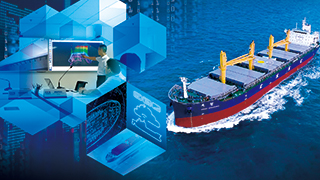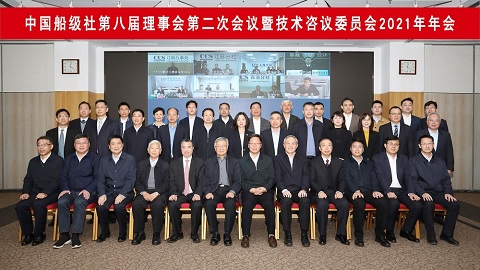With the significant advancement of zero carbon emissions target in the shipping industry, alternative fuels play a crucial role as the main force in reducing emissions, especially zero-carbon fuels.
By Ma Dan CCS Wuhan Rules &
Research Institute

With the significant advancement of zero carbon emissions target
in the shipping industry, alternative fuels play a crucial role as the main
force in reducing emissions, especially zero-carbon fuels. Green ammonia is one
of the main zero-carbon fuels, and is considered a strong candidate for
alternative fuels in the international shipping industry by virtue of its great
potential for application to solve medium and long-term decarbonization
targets. The establishment and improvement of the rules and standards for
ammonia-fuelled vessels is of great significance for the safe and reliable
application of ammonia fuel on ships. This paper mainly sorts out and analyzes
the current status of the rules and standards for ships using ammonia fuel,
which include the International Maritime Organization (IMO), the International
Association of Classification Societies (IACS), the International Organization
for Standardization (ISO), major classification societies, and national
standards (including established and ongoing codes and standards), and proposes
the ideas for future construction, with the aim to provide comprehensive
technical support for the safe and sound development of ammonia-fueled vessels.
International Maritime
Organization (IMO)
In terms of IGF, its main sections PART A-1, PART B-1, and PART
C-1 are currently only applicable to natural gas fuel, while the regulations
related to ammonia fuel will be developed within the framework of IGF and
initially released in the form of interim guidelines. The interim guidelines
are to be finalized at the CCC 10 meeting of the Subcommittee on Containers and
Cargoes in 2024 and approved at the Maritime Safety Committee (MSC) meeting in
2025. This interim guideline is expected to provide specific provisions on the
objectives and functional requirements, risk assessment, vessel design and
arrangement, fuel containment system, material and piping design, fuel
bunkering, fuel supply, power generation and propulsion system, fire
protection, toxicity protection, ventilation, electrical installations,
control, monitoring and safety system, manufacturing, process and testing,
drills and emergency drills, operation requirements, training, personal
protection, etc. The main difference between this interim guideline and the IGF
rules is that the requirements related to ammonia fuel toxicity protection are
added, while the requirements for fire and explosion prevention are reduced.
In terms of IGC, the requirement to prohibit the use of toxic
cargoes as fuel has now been revised to allow ammonia cargoes used as fuel.
However, the existing IGC Chapter 16 "Using Cargo as Fuel" only
applies to methane cargo, and the relevant technical requirements for ammonia
cargo as fuels are currently being discussed and formulated. The relevant draft
has been submitted to the CCC 10 meeting, and the technical requirements mainly
include: objectives and functional requirements, supplementary guidance to
Chapter 16, additional provisions (risk assessment, arrangement of spaces
accommodating gas fuel users, fuel supply, ventilation and liquid/gas detection
of fuel spaces, combustion equipment). For liquefied gas carriers using ammonia
fuel (non-cargo), relevant technical requirements are also being discussed,
mainly focusing on the following aspects: (1) how to distinguish between
ammonia fuel tanks and cargo holds; (2) requirements for separation between
fuel and cargo pipelines; (3) different requirements for ventilation of cargo
holds and fuel tanks; (4) personal protective requirements for goods and fuels;
(5) different requirements for the classification of hazardous areas for goods
and fuels; (6) the impact of requirements related to toxicity areas of ammonia
on cargo operation; (7) the risks and related requirements of simultaneous
operation of cargo loading and unloading and fuel bunkering.
International Association
of Classification Societies (IACS)
IACS established the "Safety Decarbonization Panel
(SDP)" in 2022 to be responsible for making research on the standards
related to the application of alternative fuels such as methanol, ammonia,
hydrogen, etc. on ships and other decarbonization technologies. On the one
hand, IACS actively participated in the discussion and preparation of the IMO
"Interim Guidelines for Ammonia Fuels", conducted GAP analysis
between ammonia fuel and IGF rules in the early stage, and provided feedback to
the IMO Alternative Fuel Communication Group. Subsequently, IACS issued
technical opinions and relevant positions on the draft of the "Interim
Guidelines for Ammonia Fuels" submitted by the Alternative Fuel
Communication Group; on the other hand, IACS SDP actively organized and
developed unified requirements/interpretations related to ammonia-fuelled
vessels. Currently, the formulation and official release of the unified requirement
UR H1-Control of Ammonia releases in Ammonia fuelled vessels have been
completed. This UR has defined the hazardous ammonia concentration, normal
working conditions, abnormal working conditions, and emergency situations of
ammonia-fuelled vessels, and puts forward clear and strict control requirements
for ammonia release from ammonia-fuelled vessels on this basis. At the same
time, IACS SDP has also continuously conducted research on the UR list related
to ammonia fuel. In the next stage, the UR that may be prioritized for
development is the Design and testing of ammonia treatment system in ammonia
fuelled vessels, which aims at proposing relevant technical requirements for
the equipment or systems that control the ammonia release concentration.
International Organization
for Standardization (ISO)
ISO is committed to developing and promoting various
international standards to facilitate international trade and technological
cooperation. ISO has mature experience and important role in the development of
standards for the application of anhydrous ammonia in the industrial sector.
Ammonia fuel is still at the initial stage of application in the shipbuilding
industry, and ISO has relatively little involvement in the development of
relevant standards in this field, however, considering the prospect of using
ammonia fuel for ship decarbonization, ISO is currently developing relevant
standards for marine ammonia fuel. At the same time, the relevant standards for
the application of anhydrous ammonia in the industrial sector can also serve as
a reference.
ISO/WD 23397: Ships and
marine technology---Ammonia fuel systems for ships
Marine ammonia fuel system. During the preparation process, this
standard will be based on the "Guidelines for Ships Using Ammonia
Fuel" (Interim Guideline) developed by the IMO CCC Subcommittee, which
will specify standardized terminology and related requirements for ammonia fuel
system for ships. This standard will apply to all types of ships using ammonia
fuel, except for ships that transport ammonia as cargo.
ISO/DTS 21343: Fuel
ammonia---Requirement and Guideline for boilers for power
generation---Environmental performance
This standard is in the approval stage and specifies the
guidelines for testing of ammonia combustion boiler manufacturers from design
to acceptance to meet the required environmental performance. It specifies the
testing method, measurement item, assessment method, and test reports for each
test, with NOx, NH3, and N2O measured at the combustion chamber outlet during functional
testing and at the boiler outlet during acceptance testing. The scope of
application is the equipment that meets the following conditions: 1) onshore
boilers used for power generation, with an output power of 100MW or above; 2)
using ammonia as fuel; 3) boilers with a burner for burning primary fuels.
The above ISO standards being developed can serve as a guidance
and reference for the application of ammonia-fuelled vessels. With the gradual
introduction of more relevant standards in the future, it will help further
improve the safety, reliability, and environmental friendliness of
ammonia-fuelled vessels.
Rules of Classification
Society
In addition to international organizations including IMO, IACS,
ISO, etc., major classification societies also play an important role in the
development of the rules and standards for ammonia-fuelled vessels. The
classification societies, based on the laws and regulations, technological
level, and market demands of their respective countries, have formulated the rules
for classification of ammonia-fuelled vessels based on the physical and
chemical characteristics and related risks of ammonia fuel, combined with the
actual needs of ship safety and environmental protection, which provides clear
technical guidance and requirements for the design and operation of
ammonia-fuelled vessels, and promotes the development of application technology
for ammonia-fuelled vessels.
China Classification Society (CCS) began the R&D of the
codes and standards for ammonia-fuelled vessels in 2020. In 2022, it released
the "Guidelines for Ships Using Ammonia Fuel". In response to the
main risks of ammonia fuel such as toxicity and explosiveness, this Guideline
puts forward the safety technical requirements for ship arrangement, material
and pipeline design, fuel enclosure system, fuel bunkering, fuel supply,
ammonia engine, ventilation, fire protection, explosion-proof and toxic area
division, control, monitoring and safety system, personnel protection, ammonia
fuel power system preset, etc. based on the risk assessment concept and the
relevant technical requirements of natural gas fueled ships within the
framework of IGF.
In terms of bunkering, CCS has launched the scientific research
project of the "Research on Technical Standards for Ammonia Fuel Bunkering
Ships and Operation" in 2024 to mainly carry out the research in two
aspects: one is the research on technical standards for ammonia bunkering
ships, and the other is the research on technical standards for ammonia
bunkering operation. It has carried out research on the technical standards for
the arrangement of bunkering vessels, bunkering system, cargo containment
system, related monitoring and safety system, personnel protection, evacuation,
fire protection system, etc.; as for bunkering operations, it has carried out
research on the technical requirements for bunkering modes, bunkering
equipment, safety protection, risk assessment, operating procedures, emergency
response, etc. The project results are the "Guidelines for Ships Using Ammonia
Fuel" and the "Guidelines for Marine Ammonia Fuel Bunkering
Operation", which are expected to be released around the end of 2025.
Other major classification societies around the world, such as
American Bureau of Shipping (ABS), Det Norske Veritas (DNV), Lloyd's Register
of Shipping (LR), Class NK (NK), Bureau Veritas (BV), Registro Italiano Navale
(RINA), Korean Register (KR), etc., have also issued the rules or guidelines
for ammonia-fuelled vessels in recent years.
National Standards
In terms of national standards, it, to some extent, serves as a
reference for the occupational exposure limits for ammonia and the standards
for liquefied anhydrous ammonia, the allowable exposure limits for
ammonia-fuelled vessels and the determination of ammonia fuel specifications
since there is a lack of relevant standards for the application of
ammonia-fuelled vessels. Among them, GBZ 2.1 "Occupational exposure limits
for hazardous agents in the workplace" stipulates the hygiene
requirements, testing and assessment, and control principles for occupational
exposure to ammonia in the workplace; GB/T 536 "Liquefied anhydrous
ammonia" specifies the requirements, testing methods, survey rules,
packaging, labeling, storage, transportation, and safety requirements for
liquefied anhydrous ammonia.
In summary, there is a certain foundation for the development of
the regulations, rules, and standards related to ammonia-fuelled vessels
worldwide, and the corresponding rules and standards have taken shape. However,
there are still deficiencies and improvement. In the future, in-depth research
needs to be made in the following five aspects: the standards for
specifications of marine ammonia fuel; the standards for ammonia fuel
bunkering; the standards for testing ammonia fuel power plants (engines,
boilers); the standards for design and testing of ammonia fuel supply system;
the standards for design and testing of ammonia emission reduction system.
Note: If you need to reprint, please indicate the source of the information.













